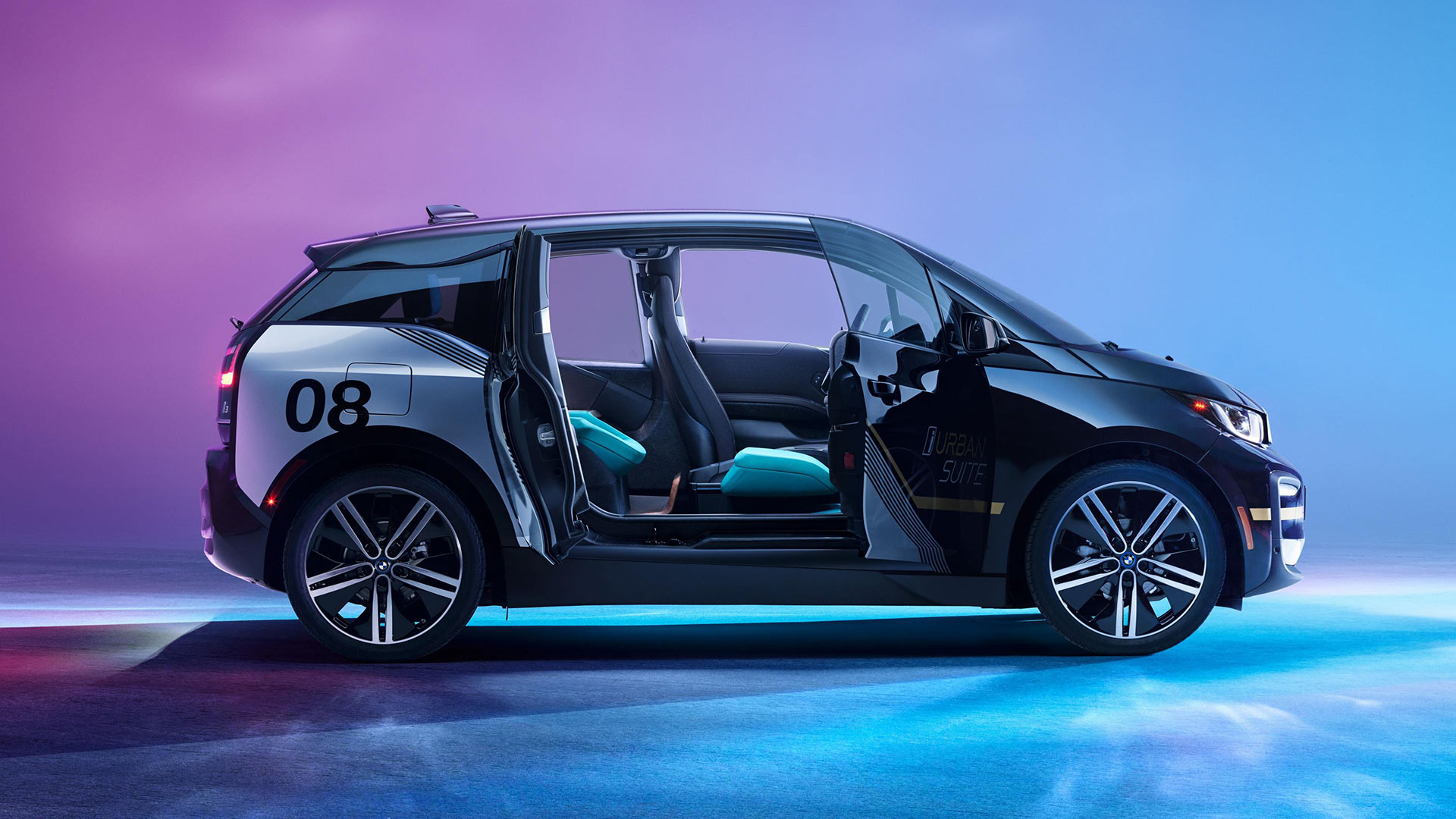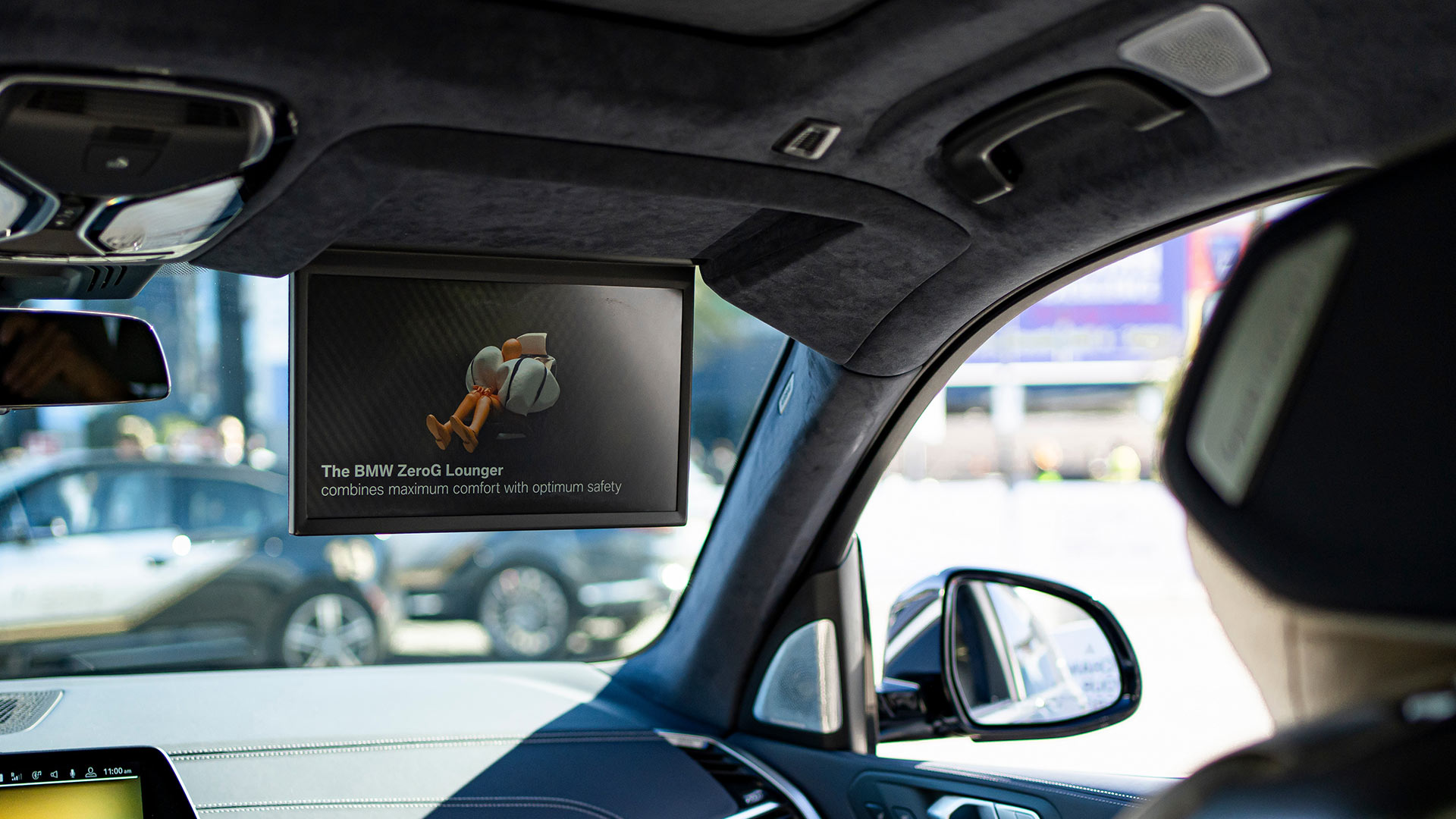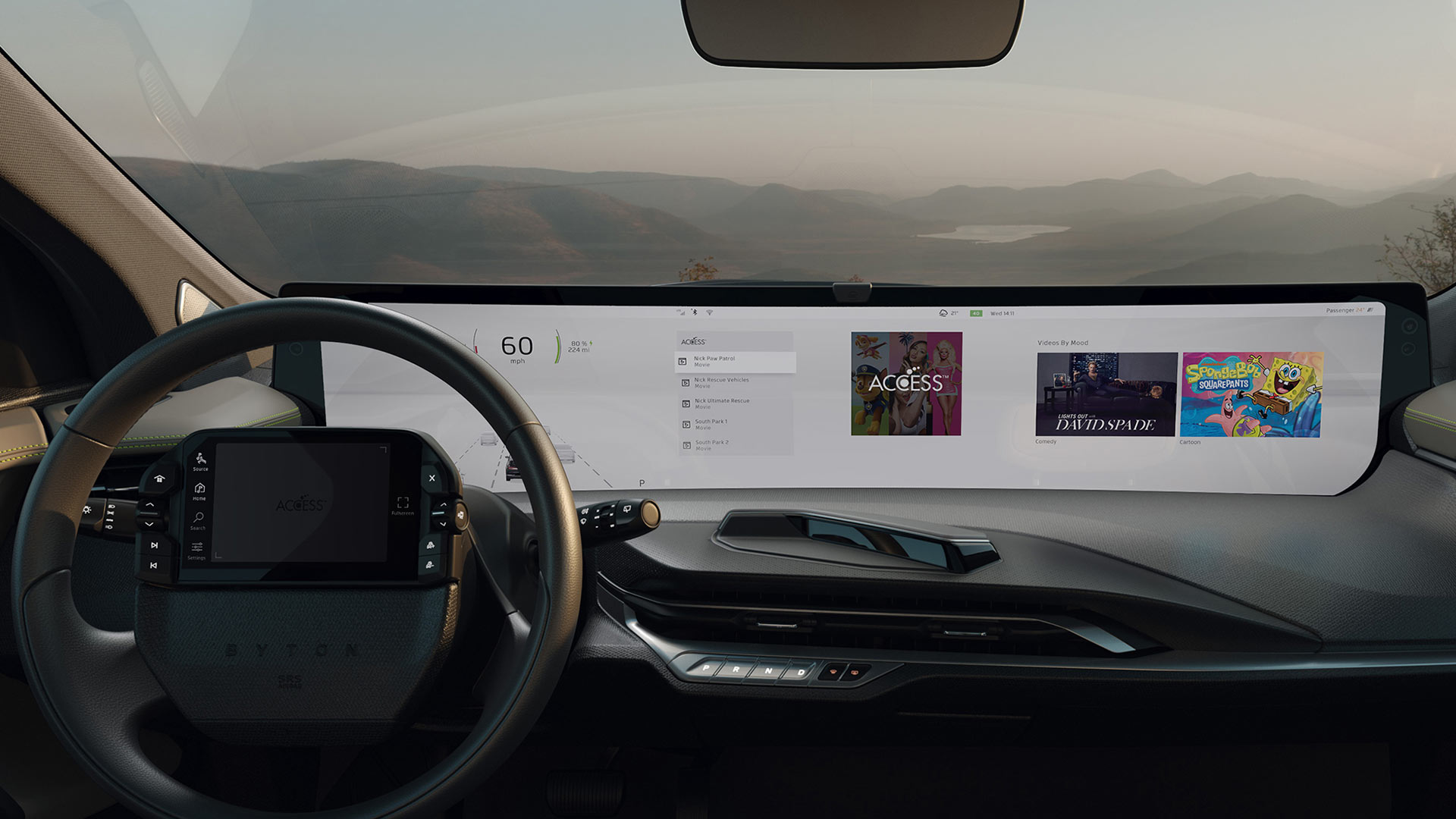
CES (formerly known as the Consumer Electronics Show) is one of the biggest technology events of the year. Held in Las Vegas, CES has become a beacon for car manufacturers and suppliers, as they seek to integrate ever-more technology into new vehicles.
Join us as we investigate the biggest automotive announcements at CES 2020.
More cool car tech on Motoring Research:
- Sony reveals Vision-S concept car at CES 2020
- JLR debuts new Pivi Pro infotainment at CES 2020
- Hyundai and Uber to develop ride-sharing air taxi
Sony’s Vision-S is a concept car from the tech giant

One of the biggest surprises at CES 2020 was the unveiling of a concept car by Sony. The Japanese technology company has created its own electric vehicle, designed to show what technology it foresees appearing in future cars.
Safety is high on the agenda, with 33 sensors throughout the Vision-S to give a 360 degree ‘safety cocoon’ for driver and passengers. A panoramic display stretches the entire width of the dashboard, whilst audio speakers are integrated into the seats.
Sony states this is only a concept vehicle, but the details make it look like production might not be an impossible dream.
Could the Fisker Ocean be the electric SUV we need?

Having been teased for months, CES 2020 is where Fisker Inc. finally launches the Ocean electric SUV. With federal tax credits the Ocean will be priced in the United States from $29,999 (£22,600), undercutting the Tesla Model Y.
Competitive and flexible leasing deals are also promised for the Ocean, which features a range of up to 300 miles from its 80 kWh battery pack. Fisker also wants the Ocean to be the most sustainable car ever made, with carpets made from recycled materials, a vegan interior, and a roof incorporating a full-length solar panel.
Production is scheduled for late 2021, with the first deliveries to customers in 2022.
Meet the high-tech rush hour refuge – the Audi AI ME

Dealing with the daily commute can be a grind, but Audi wants the AI:ME to offer a break from the stresses of gridlock. Billed as being an ‘empathetic car’, the AI:ME is able to pick an interior lighting scheme based upon how the driver is feeling. It can also learn climate control preferences, and even which air freshener scent is most liked.
Passengers in the AI:ME can wear VR goggles to experience a ‘wellness experience’ of a mountain view, whilst the car orders takeaway food to be delivered on time. The AI:ME also routes drivers the best way to avoid traffic, helping further reduce stress.
Mercedes-Benz and James Cameron team up for AVTR concept

Developed with the people responsible for the Avatar movie, this Mercedes-Benz concept is intended to display the car as a living creature. The wheels took inspiration from the Tree of Souls from AVATAR, whilst the rear of the AVTR has 33 ‘bionic flaps’ that can move independently. These flaps can communicate with the driver, and the wider outside world.
Beneath the reptile-like exterior is a new graphene-based battery system, created without precious metals. Mercedes-Benz states the batteries are fully recyclable, aiding the sustainability of the AVTR. Vegan Diminica leather, and rattan flooring, add to the eco-credentials for this concept.
Jaguar Land Rover Pivi Pro is inspired by smartphones

An all-new infotainment system for future Jaguar Land Rover models has made a debut at CES 2020, ahead of being rolled out for the new Defender. Named Pivi Pro, the system shares its appearance, and technology, with modern smartphones.
Said to be ‘ultra-fast’ courtesy of the BlackBerry QNX Hypervisor platform controlling it all, Pivi Pro can also has the world’s first dual-modem, dual-eSim in-car technology. One eSIM is dedicated to software updates, whilst the other focuses on streaming music and uploading information to the cloud to be used later.
OnePlus Concept One phone uses clever McLaren glass tech

The McLaren 720S Spider uses clever electrochromic tech in its glass roof, that switches it from solid black to see-through clear glass in an instant. The technology means the firm doesn’t have to fit sunshades to its open-top supercars, saving weight… and it’s so clever, a smartphone manufacturer has now taken it up.
High-end brand OnePlus debuted the Concept One phone at CES 2020, which has miniaturized the tech to use it on its camera lenses. They switch from ‘hidden’ to ready for use in less than the time it takes to open the camera app itself. Set off with a rich McLaren Papaya Orange leather case, the phone is sadly just a concept – for now, at least…
Sennheiser and Continental make Ac2ated speakerless audio

A collaboration between audio company Sennheiser and Continental has resulted in a sound system that needs no speakers. Instead, specific surfaces throughout the interior of the vehicle are used to create sound, taking inspiration from classical music instruments.
Along with the promise of incredible 3D sound, the system also reduces weight by 90% compared to traditional speaker setups. Other benefits include car designers having more freedom to sculpt interiors, without needing to worry about speaker placement.
The BMW i3 Urban Suite is inspired by boutique hotels

BMW has a number of concepts on display at CES 2020, including a version of the electric i3 designed to offer passengers a luxurious experience. BMW admits that boutique hotels have provided the interior influence, which includes a large seat and a footrest.
A screen can be deployed from the headliner, whilst passengers benefit what BMW describes as being a personal ‘Sound Zone’. In keeping with many of the exhibits as CES 2020, BMW has used sustainable materials inside the i3 Urban Suite, including olive-tanned leather upholstery.
BMW X7 ZeroG Lounger – is this the comfiest car seat, ever?

Whilst many of the ideas on show at CES 2020 are radical ideas of the future, BMW does have at least one creation slated for future production. The X7 ZeroG Lounger will be ready for sale in around five years, and aims to seriously upgrade your car seat experience.
With an integrated seat belt and airbag system, the ZeroG Lounger allows passengers to recline up to 60 degrees, but also meet all safety requirements. A screen can also be mounted to the headliner, allowing passengers to still keep watching the infotainment display whilst reclining.
Keep it quiet with Nissan’s new acoustic meta-material

It might not be the most exciting product being previewed at CES 2020, but Nissan’s lightweight meta-material aims to make car cabins quieter whilst improving efficiency. Instead of traditional heavy insulation, the meta-material use plastic film and a lattice structure to control air movement.
This material helps deaden wide frequency band noise, such as road or engine sounds, but weighs only 25% of the equivalent contemporary insulation. Nissan also promises that its low cost, and thin size, means even economy cars will be able to benefit from the lightweight noise insulation in future.
Nissan electric twin-motor all-wheel drive technology

Using lessons learned from the performance GT-R supercar, and Patrol off-roader, Nissan has developed an electric motor system that provides instant torque to all four wheels. It boasts that handling and power delivery can be on par with dedicated sports cars, but with all the efficiency of electric power.
The 4ORCE system juggles torque between each wheel, and also helps contribute to overall passenger comfort. The level of regenerative braking can be automatically adjusted in urban situations, making stop-start traffic seem less dramatic.
Lamborghini is first for full Amazon Alexa control

Supercar manufacturer Lamborghini has become the first car manufacturer to offer full integration with Amazon’s Alexa service. The new Huracan Evo’s infotainment and climate control systems can be adjusted purely using voice commands, alongside asking for navigation data or weather updates.
Using Alexa inside a Lamborghini also allows external Alexa-connected devices, such as gates or garage doors, to be controlled through voice commands. Amazon and Lamborghini are committed to increasing the number of opportunities for Alexa to assist drivers, letting them concentrate on having fun behind the wheel.
Uber and Hyundai combine to build flying taxi

Forget ride-sharing in just a car, as the future will see a fleet or air taxis transporting passengers to their destination. That is the vision according to Hyundai and Uber, who have made a full-scale flying machine to display at CES 2020.
The all-electric S-A1 is claimed to have a potential range of up to 60 miles, and can travel at a top speed of 180 mph. Recharging will take mere minutes, whilst the cabin can accommodate four passengers and small amounts of luggage.
This is not just idle fantasy – initial flight tests are planned for later this year, with deployment possible by 2023.
Bosch developing virtual sun visors

Already chosen as the Best of Innovation in the CES 2020 Innovation Awards, Bosch’s Virtual Visor is said to be a sun visor fit for the future. Instead of traditional materials, the Virtual Visor uses an LCD screen fitted with a camera to monitor the driver or passenger.
Artificial intelligence monitors facial landmarks, and then reacts to darken sections of the LCD screen to block out light from the driver’s eyes. As the car moves, the visor adjusts to maintain coverage, whilst the remainder of the visor remains transparent.
Chrysler has a special Airflow Vision concept car

Taking a name from a radical Chrysler produced in the 1930s, the Airflow Vision is a demonstration of how car and driver will interact in the future. Based on the Chrysler Pacifica Hybrid, the flat floor of the interior is aimed at maximizing space, along with materials chosen for their calming hues.
Multiple display screens can be tailored to suit the driver and passenger, whilst Chrysler promises they will also be easy and safe to use on the move. Other intriguing elements include the use of LED crystal lighting, plus wheels said to have been inspired by the insides of an electric motor.
Jeep is making three plug-in hybrid models

More conventional, but still important, Jeep is previewing three new plug-in hybrid models at CES 2020. Electrification has been seen as vital to the future of the 4×4 brand, with the company aiming to offer electric options for all models in the range by 2022.
Plug-in versions of the Wrangler, Renegade, and Compass are first to be released. All will be badged as ‘4xe’, highlight the new electric drivetrain elements. Jeep plans to release more information at motor shows throughout 2020.
Toyota wants to build a prototype connected city

Forget building cars, or even integrated transport, as Toyota wants to build an entire city of the future. Using a 175-acre site at the base of Mount Fuji, Toyota’s ‘Woven City’ will be home to 2,000 inhabitants who want to help test the technology for the next generation.
Woven City will include homes integrated with robots, AI to monitor the health of residents, and transport said to be fully zero-emissions ready. Plans for the city are already well in development, with Toyota promising to break ground on the project in 2021. Danish architect Bjarke Ingels will be responsible for the design of the city.
Harman Voice-Sensing Volume Fade to make conversations better

Turning down the volume on your car stereo could become a thing of the past, thanks to new technology from Harman. As part of its EV Plus+ Solutions package, Harman has included Voice-Sensing Volume Fade, which automatically detects when conversations are happening in the cabin.
The volume is reduced during the conversation, and then returned to normal once the talking stops, meaning no need to manually fiddle with knobs and switches. EV Plus+ Solutions is now available to car manufacturers, and allows drivers to download new software to their car as desired.
Harman 5G technology to look around corners and through objects

Another important development being shown at CES 2020 by Harman makes use of 5G communications technology. Called vehicle-to-pedestrian, the safety system is able to make use of peer-to-peer 5G signals to detect the presence of people or cyclists.
This could allow a car to automatically brake before a corner, knowing that a pedestrian is crossing the street around the bend. Pedestrians and cyclists can also receive warnings when carrying a 5G-enabled device.
NAWA Technologies crazy Racer electric bike

Based in France, NAWA Technologies has made an all-electric motorbike currently on display at CES 2020. What makes it special is a world-first hybrid battery system, which combines a lithium-ion battery with ultracapacitor technology. This is said to offer ten times more power than traditional batteries, along with improved efficiency.
Despite having only a 9 kWh battery, the NAWA Racer can cover up to 93 miles on a full charge. It can also hit 0-62 mph in 3 seconds, and power on to a top speed in excess of 100 mph. Sadly the Racer exists to solely to demonstrate NAWA’s ultracapacitor technology, meaning there are no plans for a production version.
Ford is the first customer to get Digit robots

Your next Ford might not come with a Digit robot, but you may find it delivering your packages in future. The Blue Oval has worked with Agility Robotics on its bipedal robot, which can hold parcels and carry them along routes to homes. It can also react to instructions on where to leave items, and ask for help if needed.
Ford views this as important for building the next-generation of commercial vehicles. Self-driving delivery trucks and vans could incorporate Digit into their design, allowing robots to undertake the final process of handing over your latest e-commerce order.
Control your home with a Renault

Owners of select Renaults across Europe will soon be able to control their automated homes from the comfort of their car. A partnership with French company Otodo allows for instructions to be based between car and home, for models fitted with the Easy Link system.
Instructions could include a ‘Leaving Home’ function, which turns off the lights and puts the heating system into energy-saving mode. On returning home, the driver can use the touchscreen to send commands to prepare the house for their arrival. The software will be rolled out to cars later in 2020.
Honda’s Augmented Driving Concept

Fully-autonomous vehicles are still in development, but Honda is already thinking about how drivers will react when they finally become a production reality. Enter the Augmented Driving Concept car, which demonstrates how drivers would be able to switch between manual and self-driving modes.
The Augmented Driving Concept is constantly ready to take control should it need, and lets the driver use switches to choose between eight levels of autonomous assistance. The concept also previews a new steering wheel, which operates more like a joystick in allowing the driver to control acceleration and braking by pushing and pulling on it.
The electric Byton M-Byte is now ready for production

One of the shocks at CES 2018 was the concept version of the M-Byte from Chinese manufacturer, Byton. The reason for the surprise was the giant 48-inch wide multimedia screen, spanning the full width of the dashboard. Now the production version is here, and the huge screen has made the journey to reality.
The reason for the big screen is a number of partnerships with companies like ViacomCBS, allowing for TV shows to be streamed directly to the M-Byte. Weather data from AccuWeather can also be displayed, and Byton is now seeking more brands to develop apps for the M-Byte SUV. The company is accepting reservations for the finished vehicle.